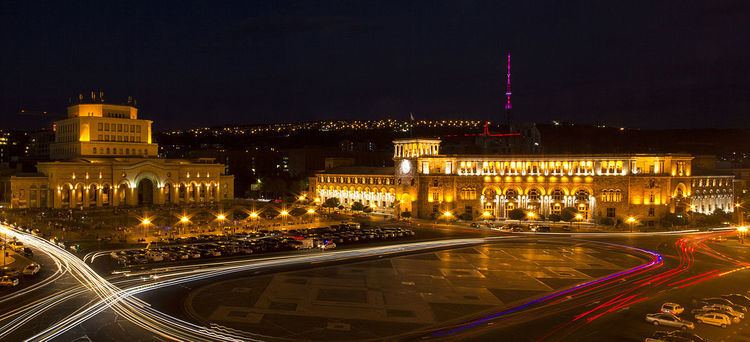Completion 1977 Area 3 ha Completed 1977 | Nearest metro station Republic Square Phone +374 77 759505 Construction started 1926 | |
 | ||
Former name(s) Lenin Square (1940–1990) Hours Open today · Open 24 hoursTuesdayOpen 24 hoursWednesdayOpen 24 hoursThursdayOpen 24 hoursFridayOpen 24 hoursSaturdayOpen 24 hoursSundayOpen 24 hoursMondayOpen 24 hoursSuggest an edit Similar History Museum of Armenia, Matenadaran, Victory Park - Yerevan, Tsitsernakaberd, Sergei Parajanov Museum | ||
Republic square yerevan armenia
Republic Square (Armenian: Հանրապետության հրապարակ, Hanrapetut′yan hraparak, known locally as Hraparak, Հրապարակ, "town square") is the central town square in Yerevan, the capital of Armenia. It consists of two sections: an oval roundabout and a trapezoid-shaped section which contains a pool with musical fountains. The square is surrounded by five major buildings built in pink and yellow tuff in the neoclassical style with extensive use of Armenian motifs. This architectural ensemble includes the Government House, the History Museum and the National Gallery, Armenia Marriott Hotel and the ministries of Foreign Affairs and Transport and Communications. The square was originally designed by Alexander Tamanian in 1924. The construction of most of the buildings was completed by the 1950s; the last building—the National Gallery—was completed in 1977.
Contents
- Republic square yerevan armenia
- Architecture
- History
- Statue of Lenin
- Replacements
- Fountains
- Christmas tree
- Drinking fountain
- Events and incidents
- References
During the Soviet period it was called the Lenin Square and a statue of Lenin stood at the square and military parades were held twice (originally thrice) a year. After Armenia's independence Lenin's statue was removed and the square was renamed. It has been described as Armenia's and the city's "most important civic space", Yerevan's "architectural highlight" and the city's "most outstanding architectural ensemble". One author suggested that it is "certainly one of the finest central squares created anywhere in the world during the 20th century."
Republic square yerevan armenia
Architecture
The square consists of two sections. The oval roundabout that has a stone pattern in the center, meant to look like a traditional Armenian rug from above. The trapezoid-shaped section which contains the musical fountain in front of the History Museum and the National Gallery. The buildings around the square are made of pink and yellow tuff stones, fortified on a basalt-made ground anchor.
History
The square was designed by Alexander Tamanian within his 1924 general plan of Yerevan. The construction of the square started in 1926, when the Government House began. It was developed until the 1950s when the rest of the five buildings were constructed and finally completed in 1977, when the National Gallery was built. The square was named Lenin Square (Armenian: Լենինի հրապարակ, Lenini hraparak; Russian: площадь Ленина ploshchad’ Lenina) for Soviet leader Vladimir Lenin. Whose statue was erected in the square in 1940 and dismantlement in 1991, prior to the independence of Armenia.
In 2003 the square was renovated and extensive excavations took place. An older layer—from the 18th-19th centuries—was uncovered.
Statue of Lenin
A 7-meter statue of Soviet leader Vladimir Lenin, erected by Sergey Merkurov and standing atop a 11 meter high pedestal, was inaugurated in the square on November 24, 1940. The monument faced the site of the planned National Gallery and "soon gained considerable acclaim as a great piece of monumental art." The statue was removed from the pedestal on April 13, 1991 prior to the formal dissolution of the Soviet Union. It was "placed on a truck and, like the body of a deceased person, driven round and round the central square as if in an open coffin" while people cheered. It is now located at the yard of the National Gallery. The pedestal survived until the summer of 1996, when it was demolished.
Replacements
Ter-Ghazaryan writes that "After the monument to Lenin was toppled, the balance of Republic Square was thrown off, and the empty space left where Lenin used to stand has been subject to various design proposals, but none has succeeded."
On December 31, 2000 a 24-meter cross lit by light-bulbs was erected in the space left empty by Lenin’s pedestal. This installation was completed on the eve of 2001, which was when the Armenian state and the Armenian Apostolic Church celebrated the 1700th anniversary of being a Christian nation. The cross was lit by 1700 symbolic lamps, and continued to be at the center of celebrations that took place throughout the year of commemoration. However, at the end of 2001, the period of celebration ended and the cross was quietly dismantled. Since it was a temporary fixture, there was little discussion preceding its erection, as well as after its dismantling.
In February 2004 a billboard-sized television screen playing advertisements for various organizations and products appeared in the empty space. It was removed in 2006.
Several competitions have been held in Armenia to select a replacement for the statue of Lenin. One of the most common proposals is to move the monument of Sasuntsi Davit (David of Sasun) to Republic Square. According to Ter-Ghazaryan the largely apolitical nature of this Armenian national hero of an epic novel would be a safe choice; however, she wrote in 2013 that the relocation of the monument from its current spot in front of Yerevan Railway Station "seems unlikely."
Fountains
After years of non-operation, the musical fountains were renovated by the French company Aquatique Show International and costed around €1.4 million. They were opened in September 2007.
Christmas tree
A Christmas tree has been installed at the square every December since at least 1950.
Drinking fountain
The drinking fountain (also known as pulpulak), located next to the museums' buildings, consists of seven fountains and is thus called Yot aghbyur ("Seven springs"). It was originally installed in 1965 and renovated in 2010.
